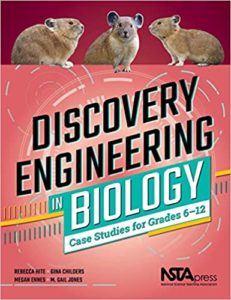Case Studies Bring Scientific Ideas to Life
Discovery Engineering in Biology: Case Studies for Grades 6-12
By Rebecca Hite, Gina Childers, Megan Ennes, and M. Gail Jones
(NSTA, 2019 – Learn more)
Reviewed by Ilana Cyna

Discovery Engineering in Biology is filled with 20 thoughtful case studies, each centering around a different scientific phenomenon or discovery. The real life case study is followed by additional thought provoking activities, with the engineering challenge closing out the lesson.

• Introduction – This includes a brief explanation of the concept to be discussed in the chapter.
• Lesson Objectives –This identifies what the student should know or be able to do after completing the lesson.
• The Case – This section introduces a case study from the past followed by a few “Recognize, Recall, and Reflect” questions.
•Three activities titled “Investigate and Explain,” “Activity,” and “Apply and Analyze” – These build off of the case study and extend the concept. They include additional scenarios (fictional but realistic); analysis of charts, maps, and graphs; research activities, and opportunities for the student to take on the role of scientist.
• Design Challenge – In this section, students are tasked with using the presented issues and discoveries to design a solution to a real world problem. The design challenge uses a scaffolded process involving these six steps: asking questions, brainstorming and imagining, creating a plan, designing, testing and evaluating, and improving and revising.
• Teacher Notes – This final section in each chapter includes lesson overviews and objectives, curriculum connections (general content, NGSS, science and engineering practices), background information, requirements for lesson preparation (materials, time, grouping, essential vocabulary), extension and assessment ideas, answer keys, and additional resources and references.
The Case Studies
I also enjoyed the offering of case studies and found them (mostly) interesting. I think it is important to know if the book offers connections to your curriculum, and so here are the 20 case studies presented in the book:
• Quit Bugging Me: Controlling Mosquitoes to Stem Malaria Infection
• Game of Knowns: John Snow’s Research into the Cause and Spread of Malaria
• Thalidomide: Hidden Strategy and Second Chances
• Vindicating Venom: Using Biological Mechanisms to Treat Diseases and Disorders
• Forbidden Fruit: The Discovery of Dangerous Drug Interactions
• Listen to Your Heart: The Accidental Discovery of the Pacemakers
• Overexposure: Treating Anaphylaxis Due to Allergies
• Crashing the Party: Combating Chronic Alcohol Abuse
• The Triumph of the Pika: Understanding Environmental Impacts on Species
• Seeing the Earth Glow From Space: Plants that Glow
• Power Plants: Algal Biofuels
• A “Sixth Sense”: Using Sensors for Monitoring and Communication
• In Hot Water: The Discovery of Tax Polymerase
• Cows and Milkmaids: The Discovery of Vaccines
• 2X or Not 2X: “Y” Should Mixed-Sex Test Subjects Be Used in Medical Research
• Revealing Repeats: The Accidental Discovery of DNA Fingerprinting
• Mr. Antibiotic, Tear Down This (Cell) Wall: The Prokaryotic Resistance of Penicillin
• Hidden in Plain Sight: Darwin’s Observation in the Galápagos Islands
• More Bark Than Bite: Using Bioprospecting to Find Cures for Disease
• Cutting it Close: Using CRISPR to Microedit the Genome
What did I love?
This book effectively uses case studies to show students how scientific ideas and discoveries came to be. The story format of the case studies is appealing and the follow-up mock scenarios are relevant and engaging, providing effective real life connections. Many of the activities are thoughtful and challenging.
The engineering design process made sense to me as it is very similar to the IB design cycle, which I taught for a few years. The EDP section of each chapter begins with providing the general challenge. For example, the general challenge in Chapter 6 (The Accidental Discovery of the Pacemakers) tasks students with finding other ways that electricity can be used to treat diseases and conditions. It continues by working through each of the six steps in the engineering design process, providing hints, video links, guiding questions, and design suggestions for the students. I found this process helpful to support the students on this journey.
There were many student templates provided throughout the book. This is where I see the book’s digital version (there’s also a print/ebook bundle) being very useful, as I find that photocopies from a book are never “neat” (and I like neat!). When I order Discovering Engineering in Physical Science, I will definitely order the digital version.
I appreciated the extensive “Teacher Notes” section. I found it thoughtfully developed with many useful guidelines for teachers. I especially liked that the answer keys were provided.
What would I change?
I feel that the organization of the case studies could have been tweaked so that the case studies with more advanced topics were all found after the less advanced ones. For example, the case study for Chapter 4 (Vindicating Venom) includes one middle school engineering standard, but all of the life science standards are for high school. In my opinion, that case study should been positioned later in the book.
I got excited when I read one of the “Recognize, Recall, and Reflect” questions in Chapter 1 (Controlling Mosquitoes to Stem Malaria Infection) which asked students to consider the ethics of human experimentation. Unfortunately, I didn’t come across any other ethical questions throughout the book, which was disappointing. I would have liked to see more of this line of questioning incorporated.
Overall, I am very happy to have this resource added to my library. I have already begun to rethink some of my curricular tasks for this year, switching them out for some of the case studies presented in this book.
Ilana Cyna is a middle school mathematics and science teacher, currently teaching through the International Baccalaureate Programme. She has taken on additional roles over her 25 years in education, including lead teacher in mathematics, science, and technology, as well as being an IB MYP Divisional lead teacher.

































